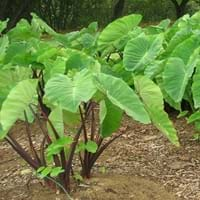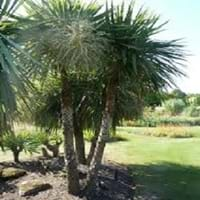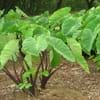Life Span
Annual
Perennial
Type
Tender Perennial
Broadleaf Evergreen
Origin
Southeastern Asia
New Zealand
Types
Eddoe taro, Dasheen taro
Not Available
Number of Varieties
Not Available
Habitat
agricultural areas, Hillside, Warm and moist climatic conditions
Coastal Regions
USDA Hardiness Zone
10-11
8-11
AHS Heat Zone
12-8
Not Available
Sunset Zone
H1, H2, 22, 23, 24
21,22
Habit
Clump-Forming
Upright/Erect
Flower Color
White, Green
White
Flower Color Modifier
Not Available
Bicolor
Fruit Color
Red
White, Blue
Leaf Color in Spring
Dark Green, Ivory
Burgundy, Dark Red, Copper
Leaf Color in Summer
Dark Green, Ivory
Burgundy, Dark Red, Copper
Leaf Color in Fall
Dark Green, Ivory
Burgundy, Dark Red, Copper
Leaf Color in Winter
Dark Green, Ivory
Burgundy, Dark Red, Copper
Leaf Shape
V-Shaped
Long Narrow
Plant Season
Spring, Summer, Fall, Winter
Spring, Summer, Fall, Winter
Sunlight
Partial shade, Full Shade
Full Sun, Partial Sun, Partial shade
Type of Soil
Loam, Sand
Loam, Sand
The pH of Soil
Acidic, Neutral
Neutral, Alkaline
Soil Drainage
Well drained
Well drained
Bloom Time
Indeterminate
Late Spring, Early Summer, Summer
Tolerances
Heat Tolerance, Humidity, Salt and Soil Compaction, Shallow soil
Drought, Salt
Where to Plant?
Container
Ground
How to Plant?
From Rhizomes
Stem Planting, Transplanting
Plant Maintenance
Medium
Medium
Watering Requirements
Needs 2-3 times watering per week, Needs a lot of water initially
Average Water Needs
In Summer
Lots of watering
Lots of watering
In Spring
Moderate
Moderate
In Winter
Average Water
Average Water
Soil pH
Acidic, Neutral
Neutral, Alkaline
Soil Type
Loam, Sand
Loam, Sand
Soil Drainage Capacity
Well drained
Well drained
Sun Exposure
Partial shade, Full Shade
Full Sun, Partial Sun, Partial shade
Pruning
No pruning needed
Prune if you want to improve plant shape, Remove damaged leaves, Remove dead leaves
Fertilizers
All-Purpose Liquid Fertilizer, Less fertilizing
All-Purpose Liquid Fertilizer
Pests and Diseases
Aphids, Rats, Snails
Red blotch
Plant Tolerance
Heat Tolerance, Salt and Soil Compaction, Shade areas
Drought
Flowers
Insignificant
Insignificant
Flower Petal Number
Not Available
Single
Foliage Texture
Bold
Coarse
Foliage Sheen
Glossy
Not Available
Attracts
Aphids, Bugs, Not Available, Snails
Caterpillar, Moths
Allergy
Swelling in mouth, Throat itching
Asthma
Aesthetic Uses
Showy Purposes
Beautification, Landscape Designing, Showy Purposes
Beauty Benefits
Poison Ivy, Skin cleanser, Weightloss
Not Available
Environmental Uses
No fertilizer, pesticides, or herbicides needed, Prevent weeds
Air purification
Medicinal Uses
Aging, Laxative, Weight loss
Diabetes, Dysentry, Stomach pain
Part of Plant Used
Leaf Stalks, Leaves
Leaves, Root, Stem
Other Uses
Used As Food, Used as Ornamental plant
Decoration Purposes, Employed in herbal medicine, Showy Purposes, Used As Food, Used as Ornamental plant
Used As Indoor Plant
No
No
Used As Outdoor Plant
Yes
Yes
Garden Design
Container, Feature Plant, Groundcover, Houseplant, Mixed Border, Tropical
Container, Feature Plant, Foundation, Houseplant, Screening, Wind Break, Tropical
Botanical Name
ALOCASIA micholitziana
CORDYLINE australis 'Red Star'
Common Name
Elephant Ear, Taro
Cabbage Palm
In German
Colocasia (Pflanzengattung)
Cabbage tree
In French
Colocasia
arbre de chou
In Spanish
Colocasia
árbol de la col
In Greek
Colocasia
λάχανο δέντρο
In Portuguese
Colocasia
repolho árvore
In Polish
Kolokazja
kapusta drzewo
In Latin
Colocasia
brassica ligno
Phylum
Magnoliophyta
Magnoliophyta
Class
Liliopsida
Liliopsida
Family
Araceae
Asparagaceae
Clade
Angiosperms, Monocots
Angiosperms, Monocots
Tribe
Colocasiodeae
Not Available
Subfamily
Aroideae
Lomandroideae
Season and Care of Taro and Cabbage Tree
Season and care of Taro and Cabbage Tree is important to know. While considering everything about Taro and Cabbage Tree Care, growing season is an essential factor. Taro season is Spring, Summer, Fall and Winter and Cabbage Tree season is Spring, Summer, Fall and Winter. The type of soil for Taro is Loam, Sand and for Cabbage Tree is Loam, Sand while the PH of soil for Taro is Acidic, Neutral and for Cabbage Tree is Neutral, Alkaline.
Taro and Cabbage Tree Physical Information
Taro and Cabbage Tree physical information is very important for comparison. Taro height is 30.00 cm and width 30.00 cm whereas Cabbage Tree height is 610.00 cm and width 240.00 cm. The color specification of Taro and Cabbage Tree are as follows:
Taro flower color: White and Green
Taro leaf color: Dark Green and Ivory
Cabbage Tree flower color: White
- Cabbage Tree leaf color: Burgundy, Dark Red and Copper
Care of Taro and Cabbage Tree
Care of Taro and Cabbage Tree include pruning, fertilizers, watering etc. Taro pruning is done No pruning needed and Cabbage Tree pruning is done Prune if you want to improve plant shape, Remove damaged leaves and Remove dead leaves. In summer Taro needs Lots of watering and in winter, it needs Average Water. Whereas, in summer Cabbage Tree needs Lots of watering and in winter, it needs Average Water.





